Family: Siricidae
Family common name: horntails
Subfamily: Siricinae
Genus: Xeris Costa, 1894
Subgenera: none
The Siricidae are called “horntails” because of the cornuscornus:
a pointed horn-like process on the apical end of the abdomen in Siricidae sawflies; on tergite 10 in females, sternite 9 in males
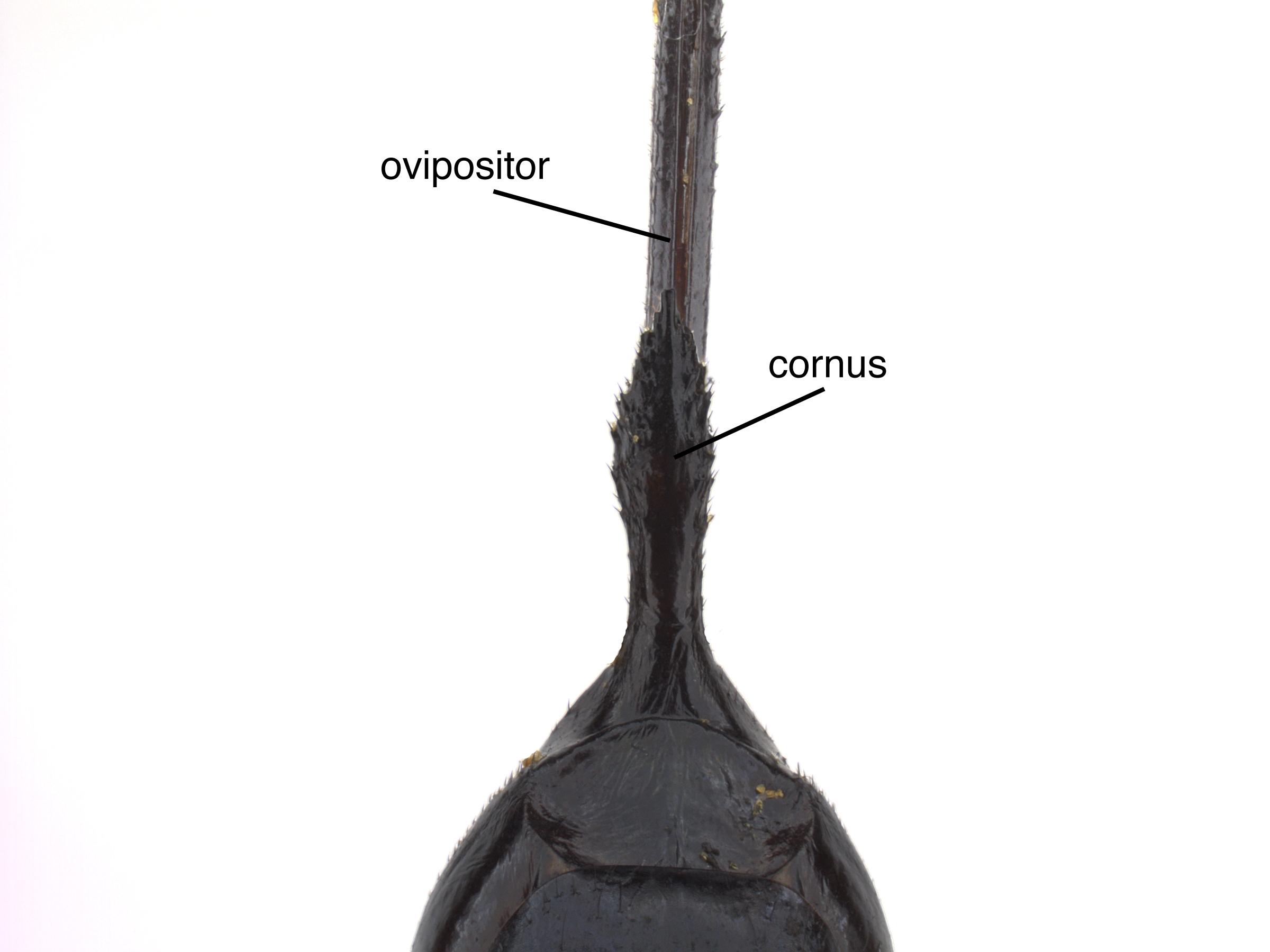 , a short spine at the apexapex:
, a short spine at the apexapex:
the end or most distal area of any structure
of the abdomenabdomen:
the third and last segment of an insect's body; in sawflies this is usually made up of 11 segments (segments 9 and 10 often fused) . Females in the family also possess a long, conspicuous ovipositorovipositor:
. Females in the family also possess a long, conspicuous ovipositorovipositor:
the female organ that deposits eggs and is used to drill into plant tissue, located at the apex of the abdomen, made up of the lance and lancet
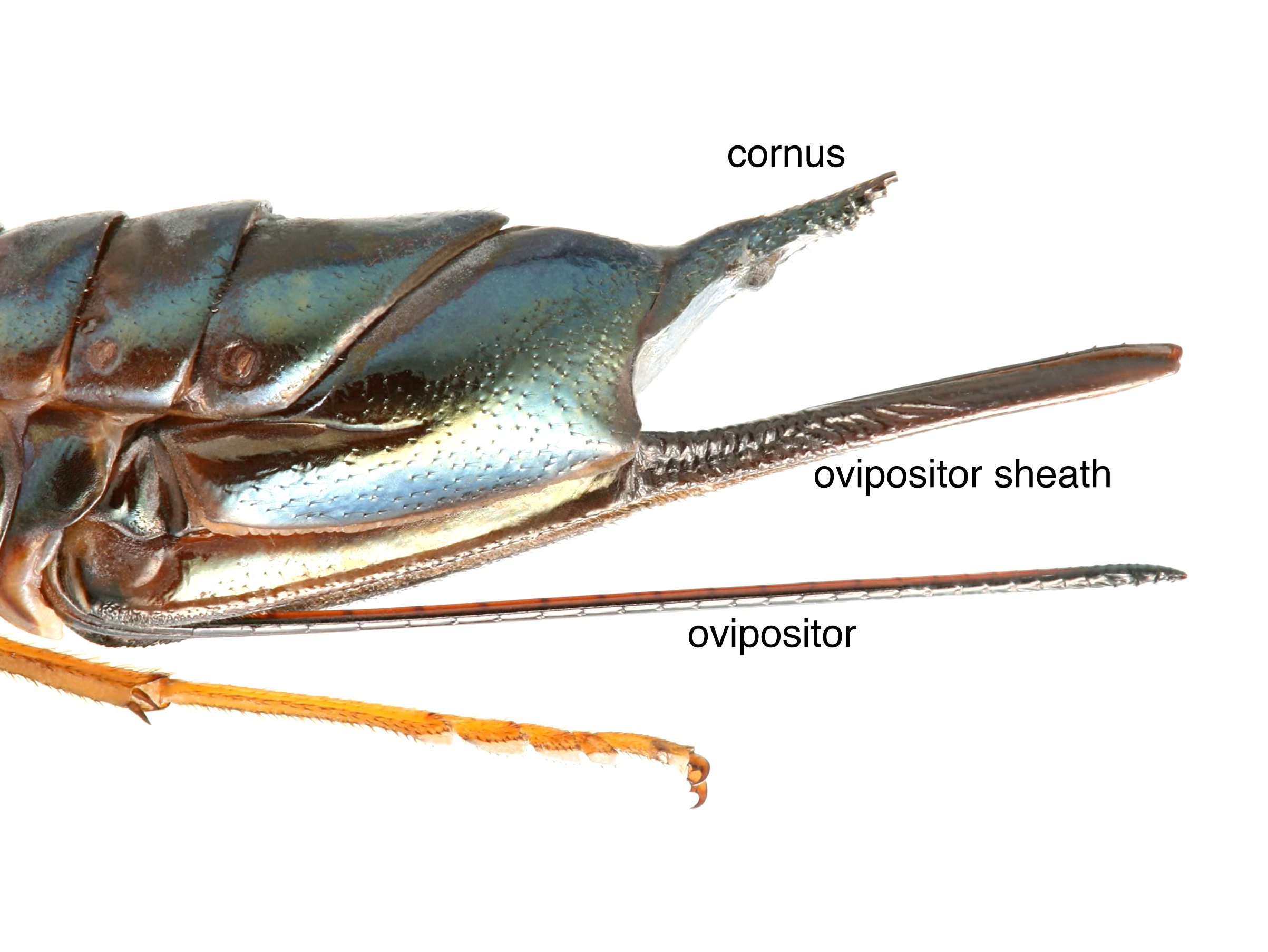 . This is often mistaken for a stinger, but it is harmless to animals and used for drilling into wood. This habit has inspired the other common name of this family: “woodwasps” (Klass 1974Klass 1974:
. This is often mistaken for a stinger, but it is harmless to animals and used for drilling into wood. This habit has inspired the other common name of this family: “woodwasps” (Klass 1974Klass 1974:
Klass C. 1974. Horntails or wood wasps. Insect Diagnotic Laboratory Cornell University.).
Horntails of the genus Xeris are generally large, but with high variation in size, ranging 9–35 mm in length. The body shape is slender and cylindrical. Females are generally larger than males, but because body size is highly variable within species, sexes are best distinguished by presence or absence of the long ovipositorovipositor:
the female organ that deposits eggs and is used to drill into plant tissue, located at the apex of the abdomen, made up of the lance and lancet
 (Goulet et al. 2015Goulet et al. 2015:
(Goulet et al. 2015Goulet et al. 2015:
Goulet H, Boudreault C, and Schiff N. 2015. Revision of the world species of Xeris Costa (Hymenoptera: Siricidae). Canadian Journal of Arthropod Identification 28: 1-127. https://doi.org/10.3752/cjai.2015.28, Schiff et al. 2006Schiff et al. 2006:
Schiff NM, Valley SA, LaBonte JR, and Smith DR. 2006. Guide to the siricid woodwasps of North America. USDA Forest Service Forest Health Technology Enterprise Team FHTET-2006-15. 102 pp.).
Worldwide, there are 16 described species. The highest diversity is in western North America (Schiff et al. 2012Schiff et al. 2012:
Schiff NM, Goulet H, Smith DR, Boudreault C, Wilson AD, and Scheffler BE. 2012. Siricidae (Hymenoptera: Symphyta: Siricoidea) of the Western Hemisphere. Canadian Journal of Arthropod Identification 21: 1-305.).
A key to North American species of Xeris is included in Schiff et al. 2012Schiff et al. 2012:
Schiff NM, Goulet H, Smith DR, Boudreault C, Wilson AD, and Scheffler BE. 2012. Siricidae (Hymenoptera: Symphyta: Siricoidea) of the Western Hemisphere. Canadian Journal of Arthropod Identification 21: 1-305..
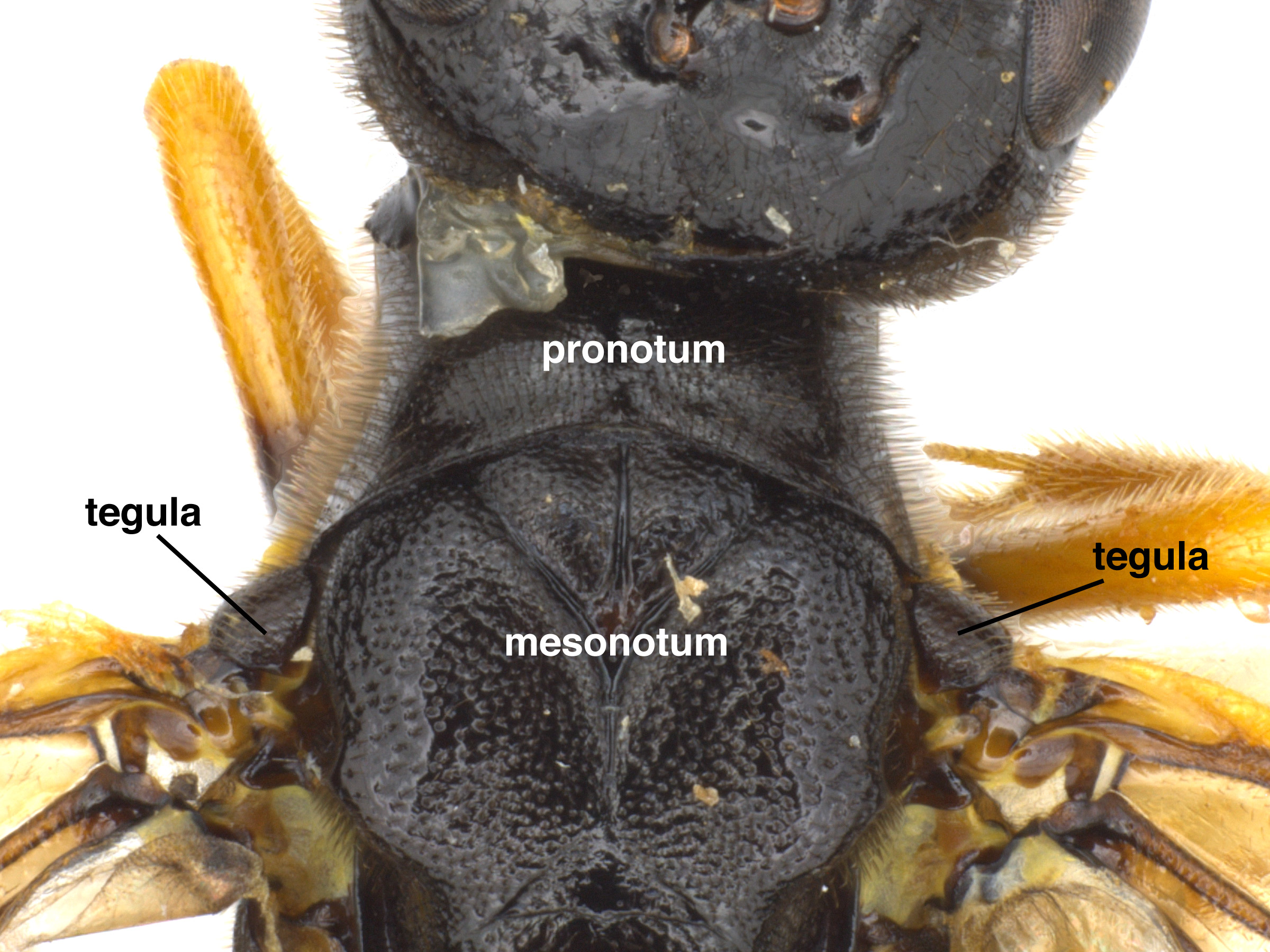 (Schiff et al. 2012Schiff et al. 2012:
(Schiff et al. 2012Schiff et al. 2012: 10 of the female, sternumsternum:
10 of the female, sternumsternum: 9 of the male, known as the cornuscornus:
9 of the male, known as the cornuscornus: (Schiff et al. 2012Schiff et al. 2012:
(Schiff et al. 2012Schiff et al. 2012: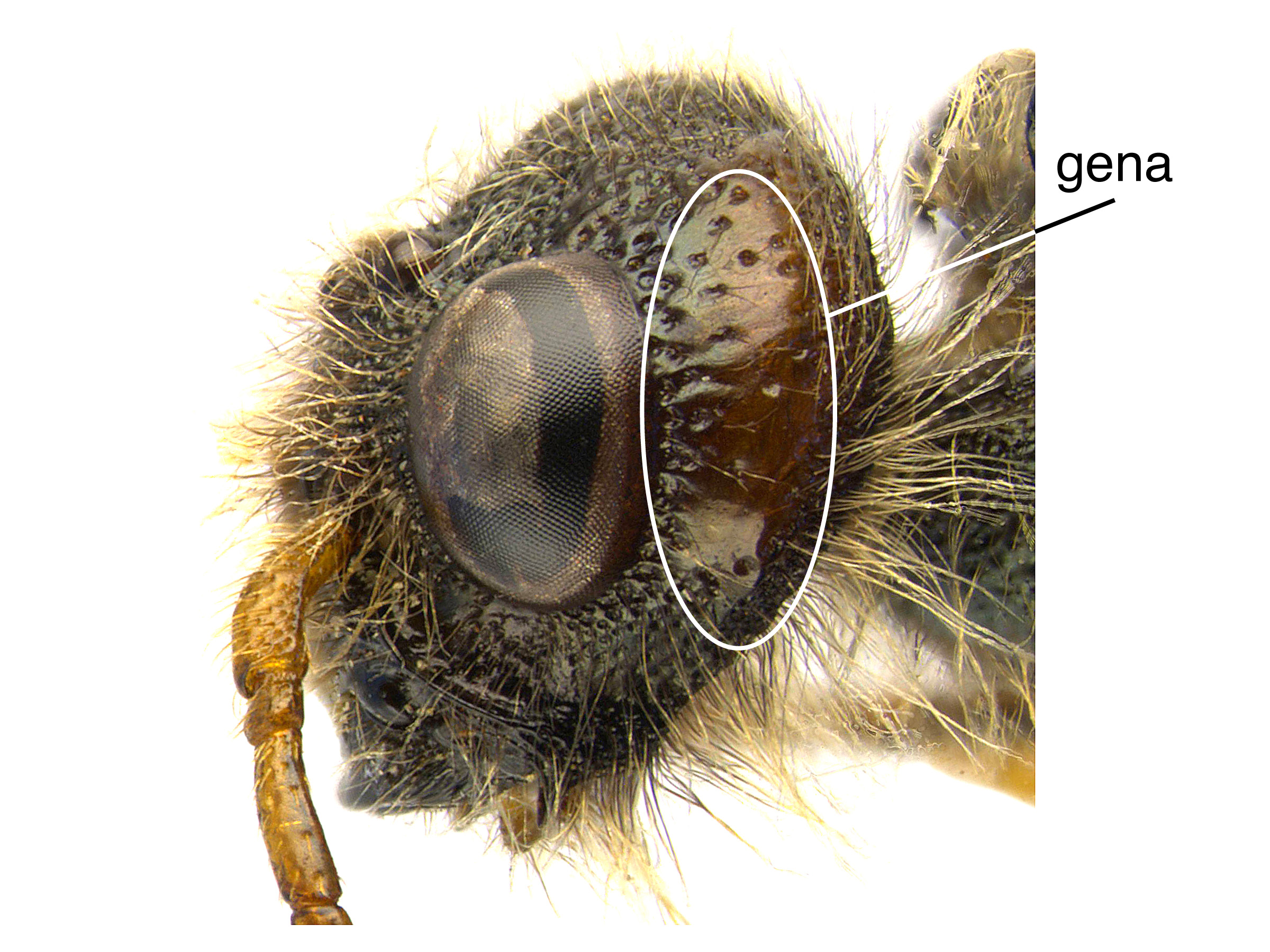 behind the eye (Schiff et al. 2012Schiff et al. 2012:
behind the eye (Schiff et al. 2012Schiff et al. 2012: (Schiff et al. 2012Schiff et al. 2012:
(Schiff et al. 2012Schiff et al. 2012: longer than the fore wingfore wing:
longer than the fore wingfore wing: (Schiff et al. 2012Schiff et al. 2012:
(Schiff et al. 2012Schiff et al. 2012:This genus may be confused with other Siricidae, especially those of the genera Sirex and Urocerus. Xeris can usually be distinguished from these genera by the long ovipositorovipositor:
the female organ that deposits eggs and is used to drill into plant tissue, located at the apex of the abdomen, made up of the lance and lancet
 , a lack of a closed anal cellanal cell:
, a lack of a closed anal cellanal cell:
cell A of either the fore wing or hind wing
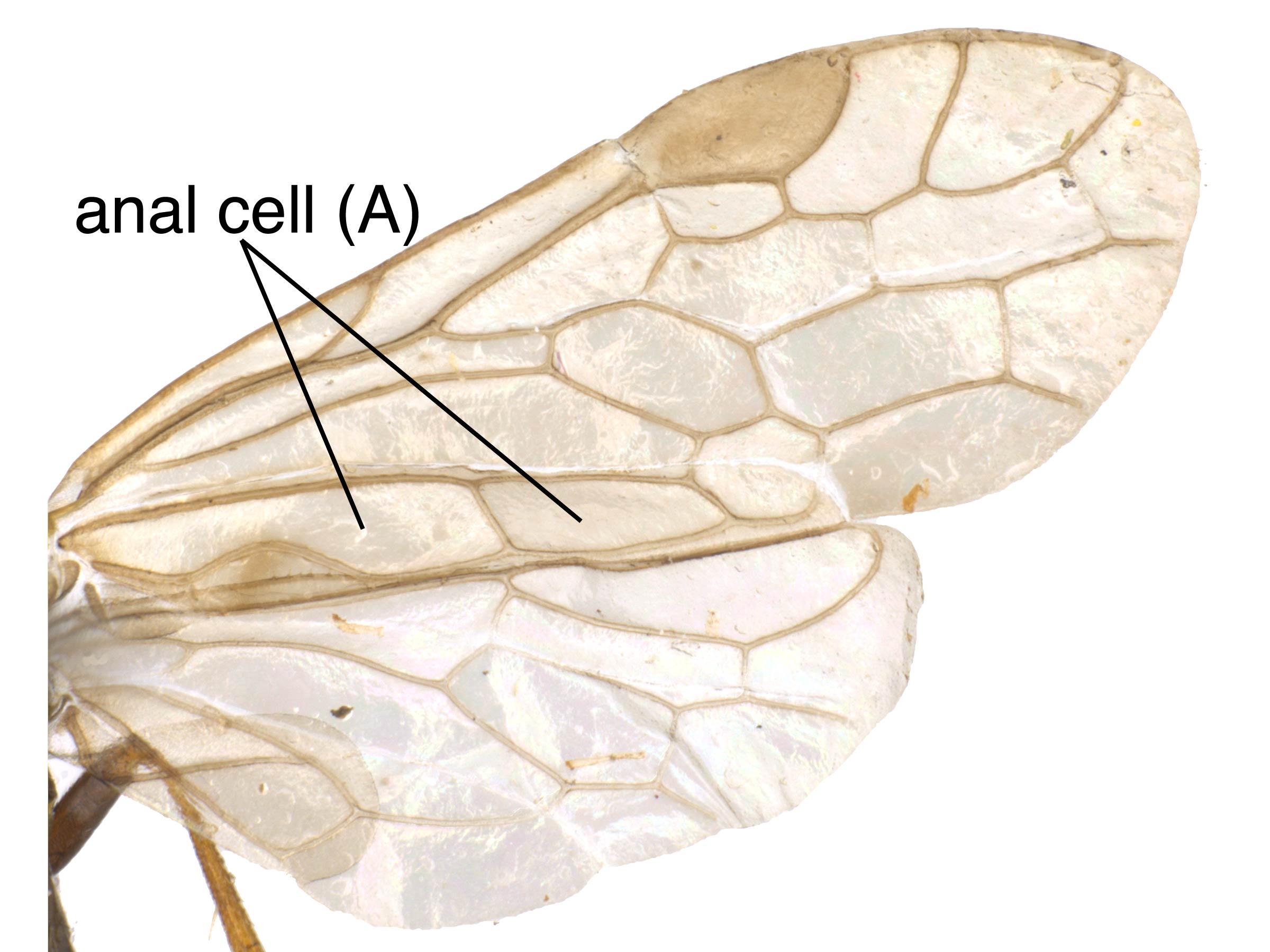 on the hind winghind wing:
on the hind winghind wing:
the posterior wing of each pair of wings
 , and a lack of metallic reflections on the body (Schiff et al. 2006Schiff et al. 2006:
, and a lack of metallic reflections on the body (Schiff et al. 2006Schiff et al. 2006:
Schiff NM, Valley SA, LaBonte JR, and Smith DR. 2006. Guide to the siricid woodwasps of North America. USDA Forest Service Forest Health Technology Enterprise Team FHTET-2006-15. 102 pp.).
Siricidae are commonly intercepted in wood packing materials at ports of entry. The potential of larval stages to persist and develop for multiple years increases the potential of successful establishment from improperly treated or disposed of wood material. There are several records of intercepted specimens at ports, but no Xeris have become established outside their native range as of yet (Goulet et al. 2015Goulet et al. 2015:
Goulet H, Boudreault C, and Schiff N. 2015. Revision of the world species of Xeris Costa (Hymenoptera: Siricidae). Canadian Journal of Arthropod Identification 28: 1-127. https://doi.org/10.3752/cjai.2015.28).
Xeris species have been documented using host trees in the Cupressaceae and Pinaeceae, including Calocedrus decurrens (incense cedar), Thuja plicata (western red cedar), Juniperus occidentalis (western juniper), Crytomeria japonica (Japanese cedar), Cupressus macrocarpa (Monterey cypress), Abies spp. (fir), Cedrus deodara (Deodar cedar), Larix spp. (larch), Picea spp. (spruce), Pinus spp. (pine), Pseudotsuga menziesii (Douglas fir), and Tsuga heterophylla (western hemlock) (Goulet et al. 2015Goulet et al. 2015:
Goulet H, Boudreault C, and Schiff N. 2015. Revision of the world species of Xeris Costa (Hymenoptera: Siricidae). Canadian Journal of Arthropod Identification 28: 1-127. https://doi.org/10.3752/cjai.2015.28).
Most female Siricidae share a similar biology, in that they harbor symbiotic basidiomycete fungus in abdominal glands called mycangia. During oviposition, the site is inoculated with the fungus, which begins to decompose the surrounding wood. LarvaeLarva:
the immature stage of holometabolous insects
 feed on the fungus, and in the process bore galleries through the wood.
feed on the fungus, and in the process bore galleries through the wood.
Though Xeris larvaelarva:
the immature stage of holometabolous insects
 have the same feeding habits, the adult female’s mycangia harbors no fungus and is essentially non-functional. Instead, females oviposit into wood already inoculated by another Siricidae species. Xeris have been documented feeding on the fungus species Amylostereum areolatum and Amylostereum chailletti which are the species associated with the genera Sirex and Urocerus (Goulet et al. 2015Goulet et al. 2015:
have the same feeding habits, the adult female’s mycangia harbors no fungus and is essentially non-functional. Instead, females oviposit into wood already inoculated by another Siricidae species. Xeris have been documented feeding on the fungus species Amylostereum areolatum and Amylostereum chailletti which are the species associated with the genera Sirex and Urocerus (Goulet et al. 2015Goulet et al. 2015:
Goulet H, Boudreault C, and Schiff N. 2015. Revision of the world species of Xeris Costa (Hymenoptera: Siricidae). Canadian Journal of Arthropod Identification 28: 1-127. https://doi.org/10.3752/cjai.2015.28). Xeris is also seemingly unique in its ability to feed on either of the two fungi without any observable preference. This generalism increases the number of suitable oviposition sites (Fukuda and Hijii 1997Fukuda and Hijii 1997:
Fukuda H and Hijii N. 1997. Reproductive strategy of a woodwasp with no fungal symbionts, Xeris spectrum (Hymenoptera: Siricidae). Oecologia 112 (4): 551-556.). Eggs are deposited in 1 small cluster per drill, 1–5 separate drills per insertion (Schiff et al. 2012Schiff et al. 2012:
Schiff NM, Goulet H, Smith DR, Boudreault C, Wilson AD, and Scheffler BE. 2012. Siricidae (Hymenoptera: Symphyta: Siricoidea) of the Western Hemisphere. Canadian Journal of Arthropod Identification 21: 1-305.).
Larvae are creamy white and grub-like in appearance with a dark head capsule. As with adults, larvaelarva:
the immature stage of holometabolous insects
 possess a short dorsaldorsal:
possess a short dorsaldorsal:
of or on the top surface of the body or structure
horn on the posterior end of the body. At maturity, the body measures about 2.5 cm in length (Schiff et al. 2012Schiff et al. 2012:
Schiff NM, Goulet H, Smith DR, Boudreault C, Wilson AD, and Scheffler BE. 2012. Siricidae (Hymenoptera: Symphyta: Siricoidea) of the Western Hemisphere. Canadian Journal of Arthropod Identification 21: 1-305.). The larvaelarva:
the immature stage of holometabolous insects
 bore galleries while developing through 6–12 larval instars, depending on food availability, until pupation and subsequent emergence. Throughout this process, the larvaelarva:
bore galleries while developing through 6–12 larval instars, depending on food availability, until pupation and subsequent emergence. Throughout this process, the larvaelarva:
the immature stage of holometabolous insects
 use their horn to pack the tunnel behind them with sawdust. Emergence holes are perfectly circular. The life cycle of Xeris species varies from 1–3 years (Schiff et al. 2012Schiff et al. 2012:
use their horn to pack the tunnel behind them with sawdust. Emergence holes are perfectly circular. The life cycle of Xeris species varies from 1–3 years (Schiff et al. 2012Schiff et al. 2012:
Schiff NM, Goulet H, Smith DR, Boudreault C, Wilson AD, and Scheffler BE. 2012. Siricidae (Hymenoptera: Symphyta: Siricoidea) of the Western Hemisphere. Canadian Journal of Arthropod Identification 21: 1-305.).
World: All species of Xeris are restricted to the North Hemisphere and tend to have somewhat distinct ranges within Europe, North Africa, South Asia, and East Asia. There is no overlap of established species in the Western and Eastern Hemispheres (Goulet et al. 2015Goulet et al. 2015:
Goulet H, Boudreault C, and Schiff N. 2015. Revision of the world species of Xeris Costa (Hymenoptera: Siricidae). Canadian Journal of Arthropod Identification 28: 1-127. https://doi.org/10.3752/cjai.2015.28).
North America: Xeris is documented throughout boreal regions of Canada and the United States, with some species restricted to the Pacific Northwest region east to Colorado, and two restricted to the southwest U.S. into northern Mexico. One species, X. tropicalis, is known only from Chiapas, Mexico (Goulet et al. 2015Goulet et al. 2015:
Goulet H, Boudreault C, and Schiff N. 2015. Revision of the world species of Xeris Costa (Hymenoptera: Siricidae). Canadian Journal of Arthropod Identification 28: 1-127. https://doi.org/10.3752/cjai.2015.28).
Map data from: GBIF.org (26 June 2019) GBIF Occurrence Download Xeris
Details about data used for maps can be found here.